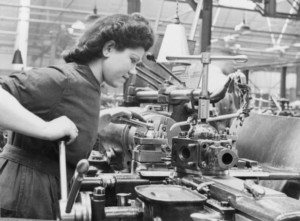 In manufacturing, a common sentiment is that the line (or generally the process) must run. There is some truth to that, but—counterintuitively—for a system to run well you need to know when to stop it too. This is my second post in a series giving you an overview on when it may be better to stop the line rather than keeping it running (and making everything worse). Keep on reading!
In manufacturing, a common sentiment is that the line (or generally the process) must run. There is some truth to that, but—counterintuitively—for a system to run well you need to know when to stop it too. This is my second post in a series giving you an overview on when it may be better to stop the line rather than keeping it running (and making everything worse). Keep on reading!
Management
All posts about management techniques, success stories, failures, etc.
Keep Calm and Stop the Line—Part 1
 In industry, I often find the view that machines must run. The reasons given for this are that the machines were expensive investments, labor cost will accumulate, and the customer is waiting for products, hence the line must run. There is definitely some truth in this. However, the conclusion that the line must not stop is completely wrong. On the contrary, for the line (or the process in general) to run well, you MUST stop the line in certain circumstances. In this and the next post I would like to look in more detail at when you, rather than pressing forward with production (or rather, your operators), should stop the line. Let me explain.
In industry, I often find the view that machines must run. The reasons given for this are that the machines were expensive investments, labor cost will accumulate, and the customer is waiting for products, hence the line must run. There is definitely some truth in this. However, the conclusion that the line must not stop is completely wrong. On the contrary, for the line (or the process in general) to run well, you MUST stop the line in certain circumstances. In this and the next post I would like to look in more detail at when you, rather than pressing forward with production (or rather, your operators), should stop the line. Let me explain.
The Toyota KPI Dashboard—Overview
 Dashboards, in their many forms, are essential to track the performance of a production system. In this post I will talk more about the Toyota shop floor dashboard. A lot of the information is from Toyota in Japan, but the images are from Toyota UK. Keep in mind that the dashboards are not a rigid standard and there may be differences in how they are implemented in the different plants. For one thing, in Japan they are in Japanese, and in the UK in English, but there are also differences within the KPI itself. Let me tell you more in this short series on the Toyota KPI dashboards…
Dashboards, in their many forms, are essential to track the performance of a production system. In this post I will talk more about the Toyota shop floor dashboard. A lot of the information is from Toyota in Japan, but the images are from Toyota UK. Keep in mind that the dashboards are not a rigid standard and there may be differences in how they are implemented in the different plants. For one thing, in Japan they are in Japanese, and in the UK in English, but there are also differences within the KPI itself. Let me tell you more in this short series on the Toyota KPI dashboards…
When to Use Standards…and When Not
 Work standards are a key component to continuous improvement. A standard is a tool that (if used correctly) prevents drifting away from a best-practice approach to do a task. Hence, I sometimes read that everything needs a standard. However, I don’t quite fully agree with this. Let me tell you when standards are helpful, and when maybe not.
Work standards are a key component to continuous improvement. A standard is a tool that (if used correctly) prevents drifting away from a best-practice approach to do a task. Hence, I sometimes read that everything needs a standard. However, I don’t quite fully agree with this. Let me tell you when standards are helpful, and when maybe not.
How to Establish a Qualification Matrix
 The qualification matrix (also skill matrix, competence matrix, or Q-matrix, one of the few examples where Q does not stand for Quality) is a simple tool to keep track of the qualifications of your employees. It keeps track of who can do what and how well. As a tool, it is not overly complicated but rather simple. Yet, there are still some things to consider for a qualification matrix. Let’s have a look at this basic but very useful tool.
The qualification matrix (also skill matrix, competence matrix, or Q-matrix, one of the few examples where Q does not stand for Quality) is a simple tool to keep track of the qualifications of your employees. It keeps track of who can do what and how well. As a tool, it is not overly complicated but rather simple. Yet, there are still some things to consider for a qualification matrix. Let’s have a look at this basic but very useful tool.
Manufacturing in a War Zone – Part 2
Manufacturing in a War Zone – Part 1

Running smooth operations is difficult enough in peacetime. But it becomes much trickier if you are located in an area experiencing an active armed conflict. Yet, there are many active armed conflicts on the world, like Ukraine, Myanmar, Afghanistan, and others, many of which have been ongoing for decades. I have put together some of my thoughts in the hope that it may help people and factories in difficult circumstances, with special focus on the current invasion of Ukraine.
How Managers Drove Boeing into the Ground…
 Boeing is a well-known maker of large commercial aircraft. If you fly occasionally, you almost certainly have been on one of their planes. Lately, however, Boeing is better known for quality issues and crashed planes. It seems that management at Boeing skimped on quality to save cost and make deadlines. In this post I want to look closer at the management of Boeing, especially in relation to the safety of the Boeing 737 MAX 8. Besides using different news sources, this article is mostly based on the book Flying Blind by Peter Robinson (source below).
Boeing is a well-known maker of large commercial aircraft. If you fly occasionally, you almost certainly have been on one of their planes. Lately, however, Boeing is better known for quality issues and crashed planes. It seems that management at Boeing skimped on quality to save cost and make deadlines. In this post I want to look closer at the management of Boeing, especially in relation to the safety of the Boeing 737 MAX 8. Besides using different news sources, this article is mostly based on the book Flying Blind by Peter Robinson (source below).

